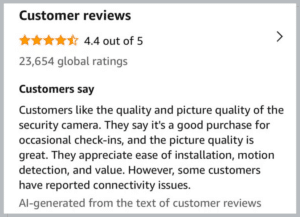Top Email Conference Takeaways to Implement in 2024
With so many conferences to choose from throughout the year, it’s challenging to prioritize which ones to attend and which to sit out on (and feel FOMO 😭) while patiently waiting for recordings and recaps.
If you didn’t get a chance to join one this year—or you attended so many and need a refresher on what you learned—read on! The Litmus Team divided and conquered a fair amount of conferences this year (including our own) and did a round-up of our favorite takeaways and how to incorporate them into your 2024 email marketing strategy.
1. AI is extraordinary, but how do we use it for email?
A hot topic in 2022, and an even hotter topic in 2023. (We can only assume 2024 will be nuclear!) Although AI isn’t new, the release of DALL-E 2 and ChatGPT began to rise in popularity in 2022 across our personal and professional lives.
This year was no different. We saw AI take every industry by storm, which left us email marketers scratching our heads on how to best use it for email. (Still puzzled by AI? Learn about the 4 types of AI and the most-used AI platforms marketers use.)
So, how is everyone using AI? Some are using it to brainstorm their email content strategy. Others are creating alternative subject lines, preview text, and body copy against their tried and true email control versions (with modifications, of course). Like Leah Miranda said during the “Exploring the Impact of AI on Email Marketing” panel at Litmus Live 2023, “Generative AI gets you 80-90% of the way there.” The rest is up to you—including revising your query results to avoid any inaccurate statements and make it sound more like your brand voice.
However, there might be times when you want to use Generative AI verbatim, such as summarizing product reviews. In these scenarios, transparency is key! If you used AI to create content for you, announce it to your audience so they’re aware.

Teams of all sizes are also leaning on AI for help with email segmentation, automating tedious tasks, or simplifying their email workflows. The options are endless, but many email marketers were rolling up their sleeves and experimenting with how to incorporate AI in their workflow to brainstorm and alleviate some of the heavy lifting.
“Don’t do a presentation on AI because you kind of have to scrap it and start over.” — Matthew Dunn, Email Innovations Summit
Although Matthew was joking, there was some truth because AI is constantly evolving, and there’s still much to learn. While AI regulations have yet to be established, our team has put together our recommended guiding principles on how to best use AI in email, such as vetting your vendors or regularly checking your results for bias and discrimination.
2. Zero and first-party data are your keys to hyper-personalization (and list hygiene)
Let’s set some things straight since these terms are often tossed around in the email world. You might wonder, “What’s the difference between zero-party and first-party data? Are there any others?” Worry not, email friend—we’ve got you covered.
- Zero-party data is individual-level data given to you directly from your audience
- First-party data is individual-level data collected from your audience on your own channels
- Second-party data is individual-level data acquired from a trusted partner (someone else’s first-party data)
- Third-party data is aggregate data collected from one or more sources
Since that’s been cleared up, which ones do we like and which ones not as much? Zero and first-party data are your safest picks since you own that data. Second-party is another option as it comes from a trusted source that allows you to access and use it. Third-party is not as desirable due to its data integrity, which could cause problems with your email sender reputation down the road. With Yahoo and Gmail’s new deliverability rules being implemented in February 2024, if your brand sends over 5,000 emails daily, you’ll want to ensure that you maintain a spam complaint rate under 0.3%.
TL;DR Don’t buy an email list! While increasing your email audience in the short term may seem tempting, there can be many long-term consequences. Spam complaints and hard bounces will damage your brand’s sender reputation, which could ultimately result in your emails not ending up in any of your subscribers’ inboxes.
How to get started with hyper-personalization
Now, let’s get into hyper-personalization. Over 80% of customers are more likely to purchase from brands that offer personalized experiences, so personalization should be front and center in your email marketing strategy. In our 2023 State of ESPs Report, 71% of respondents use personalization in their subject lines, and 63.7% personalize with dynamic content. We can probably all agree that personalization has evolved past “Hi {{ first name }}.”
To get started, first, re-evaluate your brand’s goals to determine what personalized elements will drive the most impact for your subscribers, by looking for patterns in your zero-party and first-party data. This means the data you’ve collected from forms like your email preference center, customer profiles, or questionnaires, and audience behavior across your marketing channels.
Then, ask this question: what are you trying to achieve through personalization? Can you create personalized versions based on where your customers are in their subscriber journey? Suppose you don’t have the data points to achieve your goals. In that case, it might be time to revisit your email preference center strategy so you can begin collecting that information or stand-up product quizzes or surveys to gather customers’ interests.
Once you have your data in order, it’s time to begin personalizing! How? Litmus Personalize helps you get started quickly with no code, easy-to-use templates, such as countdown timers, progress bars, or Instagram feeds to add a personalized flair to your emails.
3. Accessibility isn’t just a ‘nice to have,’ it’s a must
No email program is complete without accessibility measures in place! Accessibility is such a key pillar of delivering an ideal email experience. The importance of accessible email experiences in every email program was chatted about across many conferences this year.
Just like how we design pixel-perfect emails across all email clients, it’s important to also create visually inclusive emails for those with visual impairments. While email marketers are already busy, we are responsible for advocating for inclusive experiences by incorporating these practices into our workflow. And Tylor Loposser at Litmus Live agrees too: “Use your passion and education to convince people that this endeavor is important.”
Tylor wasn’t the only one stressing the importance of accessibility. Mark Robbins and Naomi West shared their stats on how 99.9% of emails fail basic accessibility testing.
“Hire a specialist for accessibility to join your team. If you can’t, get a consultant or become an expert yourself.” — Mark Robbins, Litmus Live
Add accessibility training (or headcount if you can) to your goals for next year.
Places to keep an eye on in your email:
- Text readability. Is your text large enough to read and is there a high contrast against your email background color?
- ALT attributes. Are these attributes properly styled and descriptive enough for screen readers or if your images don’t display?
- Call-to-action buttons and links. Are these elements easy to click or tap and are the copy for your links helpful for your readers?
And the list goes on. These are just some of the ways to easily scan your emails for accessibility areas to be added to your QA process. (Looking to make your email pre-send checklist more efficient? Use these 29 “checks” to look out for as a jumping-off point while adding some of your own.)
Break out of “this is how we’ve always done it”
2024 will be all about thinking outside the box and iterating on what you’ve done previously. What worked and what didn’t? Remember to audit your email program regularly and keep track of your email performance to determine what areas need improvement.
And with that, the 2023 marketing conference season has ended! Use these takeaways to prioritize what to focus on in your email program, and stay tuned to see which ones we’ll be attending next year.

Tracie Pang
Tracie Pang is the Email Marketing Manager at Litmus
